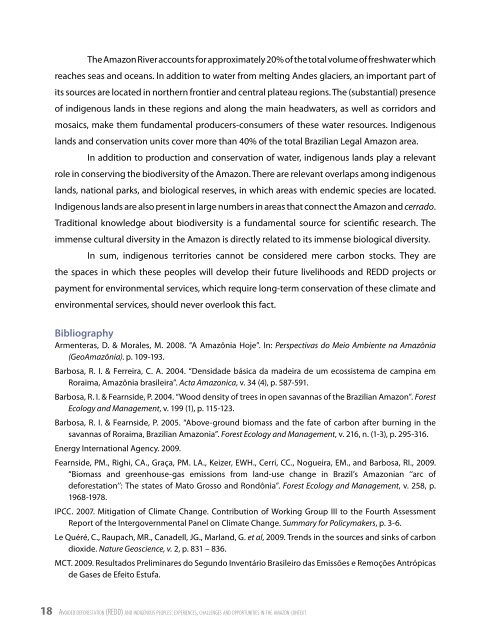Avoided Deforestation (REDD) and Indigenous ... - Amazon Fund
Avoided Deforestation (REDD) and Indigenous ... - Amazon Fund
Avoided Deforestation (REDD) and Indigenous ... - Amazon Fund
You also want an ePaper? Increase the reach of your titles
YUMPU automatically turns print PDFs into web optimized ePapers that Google loves.
The <strong>Amazon</strong> River accounts for approximately 20% of the total volume of freshwater which<br />
reaches seas <strong>and</strong> oceans. In addition to water from melting Andes glaciers, an important part of<br />
its sources are located in northern frontier <strong>and</strong> central plateau regions. The (substantial) presence<br />
of indigenous l<strong>and</strong>s in these regions <strong>and</strong> along the main headwaters, as well as corridors <strong>and</strong><br />
mosaics, make them fundamental producers-consumers of these water resources. <strong>Indigenous</strong><br />
l<strong>and</strong>s <strong>and</strong> conservation units cover more than 40% of the total Brazilian Legal <strong>Amazon</strong> area.<br />
In addition to production <strong>and</strong> conservation of water, indigenous l<strong>and</strong>s play a relevant<br />
role in conserving the biodiversity of the <strong>Amazon</strong>. There are relevant overlaps among indigenous<br />
l<strong>and</strong>s, national parks, <strong>and</strong> biological reserves, in which areas with endemic species are located.<br />
<strong>Indigenous</strong> l<strong>and</strong>s are also present in large numbers in areas that connect the <strong>Amazon</strong> <strong>and</strong> cerrado.<br />
Traditional knowledge about biodiversity is a fundamental source for scientific research. The<br />
immense cultural diversity in the <strong>Amazon</strong> is directly related to its immense biological diversity.<br />
In sum, indigenous territories cannot be considered mere carbon stocks. They are<br />
the spaces in which these peoples will develop their future livelihoods <strong>and</strong> <strong>REDD</strong> projects or<br />
payment for environmental services, which require long-term conservation of these climate <strong>and</strong><br />
environmental services, should never overlook this fact.<br />
Bibliography<br />
Armenteras, D. & Morales, M. 2008. “A Amazônia Hoje”. In: Perspectivas do Meio Ambiente na Amazônia<br />
(GeoAmazônia). p. 109-193.<br />
Barbosa, R. I. & Ferreira, C. A. 2004. “Densidade básica da madeira de um ecossistema de campina em<br />
Roraima, Amazônia brasileira”. Acta <strong>Amazon</strong>ica, v. 34 (4), p. 587-591.<br />
Barbosa, R. I. & Fearnside, P. 2004. “Wood density of trees in open savannas of the Brazilian <strong>Amazon</strong>”. Forest<br />
Ecology <strong>and</strong> Management, v. 199 (1), p. 115-123.<br />
Barbosa, R. I. & Fearnside, P. 2005. “Above-ground biomass <strong>and</strong> the fate of carbon after burning in the<br />
savannas of Roraima, Brazilian <strong>Amazon</strong>ia”. Forest Ecology <strong>and</strong> Management, v. 216, n. (1-3), p. 295-316.<br />
Energy International Agency. 2009.<br />
Fearnside, PM., Righi, CA., Graça, PM. LA., Keizer, EWH., Cerri, CC., Nogueira, EM., <strong>and</strong> Barbosa, RI., 2009.<br />
“Biomass <strong>and</strong> greenhouse-gas emissions from l<strong>and</strong>-use change in Brazil’s <strong>Amazon</strong>ian ‘‘arc of<br />
deforestation’’: The states of Mato Grosso <strong>and</strong> Rondônia”. Forest Ecology <strong>and</strong> Management, v. 258, p.<br />
1968-1978.<br />
IPCC. 2007. Mitigation of Climate Change. Contribution of Working Group III to the Fourth Assessment<br />
Report of the Intergovernmental Panel on Climate Change. Summary for Policymakers, p. 3-6.<br />
Le Quéré, C., Raupach, MR., Canadell, JG., Marl<strong>and</strong>, G. et al, 2009. Trends in the sources <strong>and</strong> sinks of carbon<br />
dioxide. Nature Geoscience, v. 2, p. 831 – 836.<br />
MCT. 2009. Resultados Preliminares do Segundo Inventário Brasileiro das Emissões e Remoções Antrópicas<br />
de Gases de Efeito Estufa.<br />
18 Av o i d e d d e f o re s t A t i o n (redd) A n d i n d i g e n o u s p e o p l e s: experiences, chAllenges A n d o p p o r t u n i t i e s in t h e A m A zo n c o n t e x t
















